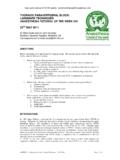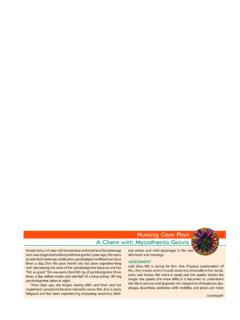Transcription of 122 Myasthenia Gravis - FRCA
1 ANAESTHESIA AND Myasthenia Gravis . ANAESTHESIA TUTORIAL OF THE WEEK 122. 15TH DECEMBER 2008. Dr Arnab Banerjee Hospital Luton & Dunstable Hospital NHS Trust Correspondence to INTRODUCTION. Myasthenia Gravis (MG) is an autoimmune disease characterized by weakness and fatigability of skeletal muscles, with improvement following rest. It may be localized to specific muscle groups or more generalized. MG is caused by a decrease in the numbers of postsynaptic acetylcholine receptors at the neuromuscular junction, which decreases the capacity of the neuromuscular end-plate to transmit the nerve signal. Initially, in response to a stimulus resulting in depolarization, acetylcholine is released presynaptically which results in a muscle action potential being generated. In MG, the number of activated postsynaptic receptors may be insufficient to trigger a muscle action potential.
2 Further, with repeated stimulation, the decline in release of acetylcholine correlates with the characteristic fatigability. PATHOPHYSIOLOGY. Auto-antibodies develop against acetylcholine (ACh) nicotinic postsynaptic receptors. Cholinergic nerve conduction to striated muscle is impaired by a mechanical blockage of the binding site by antibodies and, ultimately, by destruction of the postsynaptic receptor. Patients become symptomatic once the number of ACh receptors is reduced to approximately 30% of normal. The antibodies to the acetylcholine receptor reduce the number of functional receptors by blocking the attachment of acetylcholine molecules, by increasing the rate of degradation of receptors and by complement induced damage to the neuromuscular junction. The cholinergic receptors of smooth and cardiac muscle have a different antigenicity than skeletal muscle and are not affected by the disease.
3 MG may be associated with other disorders of autoimmune origin such as thyroid hypofunction, rheumatoid arthritis and systemic lupus erythematosus. The role of the thymus in the pathogenesis of MG is not entirely clear, but 75% of patients with MG have some degree of thymus abnormality (eg, hyperplasia in 85% of cases, thymoma in 15% of cases). However, the stimulus that initiates the autoimmune process has not been identified. An immunoregulatory defect has been postulated, and there is evidence of genetic predisposition. Using the most sensitive assays, AChR antibodies are detected in the sera of 85-90% of myasthenic patients. The great majority of AChR antibodies belong to the IgG. class. Antibody-negative patients are those with mild or localized Myasthenia , and may represent one end of the spectrum of Myasthenia Gravis . Most of the antibodies bind to the main immunogenic region of the alpha subunit of the endplate receptors.
4 Thus, MG is largely a post-junctional disorder characterized by a reduction of functional AChRs. EPIDEMIOLOGY. The prevalence of MG is approximately 100 per 100 000 population with incidence of 2-4. per 100 000 per annum. Mortality/Morbidity. In the past, untreated MG had a mortality rate of 30-70%, now most patients with MG have a near-normal life expectancy. Morbidity results from intermittent impairment of muscle strength, which may cause aspiration, increased incidence of pneumonia and falls. In addition, the medications used to control the disease may produce adverse effects. With prompt diagnosis and treatment, the mortality rate of myasthenic crisis is less than 5%. Race. The onset of MG at a young age is slightly more common in Asians than in other races. Sex. The male-to-female ratio in children and adults is 2:3. A female predominance exists in the young adult peak (ie, patients aged 20-30 y), and a slight male predominance exists in the older adult peak (ie, patients older than 50 y).
5 The male-to-female ratio in children with MG and another autoimmune condition is 1:5. Age. The onset peaks in neonates because of the transfer of maternal autoantibodies, in those aged 20-30 years, and in those older than 50 years. ASSOCIATED AUTOIMMUNE CONDITIONS. Thyroid abnormalities (15%), systemic lupus erythematosis, rheumatoid disease, ulcerative colitis, pernicious anaemia, vitiligo, pemphigus, polymyositis/dermatomyositis CLASSIFICATION OF MG (OSSERMAN). grade I only eyes affected, grade IIa mild generalised MG responding well to therapy, grade IIb moderate generalised MG responding less well, grade III severe generalised disease, grade IV myasthenic crisis requiring mechanical ventilation ELECTROPHYSIOLOGICAL STUDIES. Microelectrode studies indicate that the miniature endplate potential (MEPP) frequency is normal but the MEPP amplitude is reduced in Myasthenia Gravis , suggesting that the neuromuscular transmission defect is due to a reduction in the postsynaptic response.
6 The presynaptic synthesis, packaging and release of ACh are normal. In MG, a large proportion of the EPPs are subthreshold, , do not trigger an action potential, while the remainder are barely threshold. Repetitive nerve stimuli evoke successively smaller muscle action potentials indicating an increasing block of neuromuscular transmission. The most commonly used electrodiagnostic test of neuromuscular transmission is repetitive stimulation of a motor nerve while recording compound muscle action potentials (CMAPs) from an appropriate muscle. The amplitude of the initial CMAP is normal, though the average value of this measurement is less than the normal average. Repetitive stimulation at frequencies between one and five per second results in a decremental response. The decrement usually increases with increasing stimulation rate. The tested muscle must be warmed and the decrement must be measured after exhaustion to obtain the maximum diagnostic yield.
7 However nerve conduction velocity measurements are normal. CLINICAL FEATURES. The incidence is age and sex-related, with one peak in the second and third decades affecting mostly women and a peak in the sixth and seventh decades affecting mostly men. The cardinal features are weakness and fatigability of skeletal muscles, usually occurring in a characteristic distribution. The weakness tends to increase with repeated activity and improve with rest. Ptosis and diplopia occur early in the majority of patients. Weakness remains localized to the extraocular and eyelid muscles in about 15 percent of patients. When the facial and bulbar muscles are affected, there may be a characteristic flattened smile, "mushy" or nasal speech, and difficulty in chewing and swallowing. Generalized weakness develops in approximately 85 percent of patients; it may affect the limb muscles, often in a proximal distribution, as well as the diaphragm and the neck extensors.
8 If weakness of respiration becomes severe enough to require mechanical ventilation, the patient is said to be in crisis. On physical examination, the findings are limited to the motor system, without loss of reflexes or alteration of sensation or coordination. The patient's base-line strength should be documented quantitatively for later evaluation of the results of treatment. The most useful quantitative measures include timed forward-arm abduction, vital capacity, and dynamometry of selected muscles. The clinical severity of Myasthenia Gravis is usually graded functionally and regionally, as devised by Osserman. Most patients who present to the A&E have an established diagnosis of Myasthenia Gravis (MG) and are already taking appropriate medications. The activity of the disease fluctuates, and adjustments in medication dosages must be made accordingly. Non-compliance with medications, infection, and other physiologic stressors may result in a fulminant exacerbation of the disease.
9 Many other factors influence cholinergic transmission, including drugs, temperature, and emotional state. The adverse effects of many medications may provoke exacerbations; therefore, obtaining a careful medication history is important. Some of the medications reported to cause exacerbations of MG include the following: Antibiotics - macrolides, fluoroquinolones, aminoglycosides, tetracycline, and chloroquine Antidysrhythmic agents - beta-blockers, calcium channel blockers, quinidine, lidocaine, procainamide, and trimethaphan Miscellaneous - diphenylhydantoin, lithium, chlorpromazine, muscle relaxants, levothyroxine, adrenocorticotropic hormone (ACTH), and, paradoxically, corticosteroids Rarely, a patient may present with undiagnosed MG. Typical complaints are of generalized weakness and reduced exercise tolerance that improves with rest. Patients with MG do not present with primary complaints of sleepiness or muscle pain.
10 The patient may also complain of a specific weakness of certain muscle groups (eg those used when climbing stairs). In 20% of patients, MG affects the bulbar muscles alone. Eighty-five percent of patients with bulbar weakness go on to develop generalized weakness involving the limbs. TRANSIENT NEONATAL Myasthenia . Fifteen to 20% of neonates born to myasthenic mothers have transient Myasthenia , due to protective effects of alpha foetoprotein, which inhibits binding of anti-AChR antibody to AChPregnancy may produce either exacerbation or remission of the disease. Signs are usually present at birth, but occasionally may be delayed for 12- 48 hr. Maternal anti- acetylcholine receptor antibody can cross via breast milk and accentuate neonatal Myasthenia . Commonly associated features include difficulty in sucking and swallowing, difficulty with breathing, ptosis and facial weakness.















